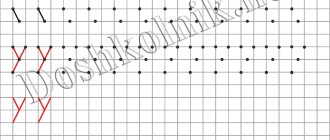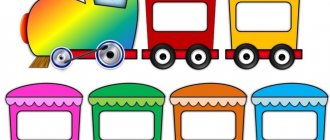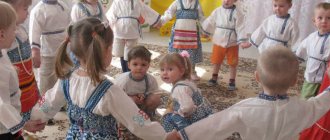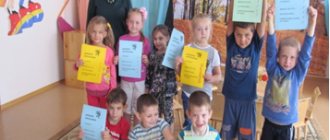Card index of didactic games in the preparatory group for speech development
Transcript
1 Card index of didactic games in the preparatory group for speech development “Finish the word” Purpose: To develop children’s ability to divide words into syllables. Progress: Children stand in a circle. Teacher with a ball Goal: To develop children’s ability to divide words into syllables. Progress: The teacher invites the children to guess the words, while tapping 2 times. Children select words with a given number of syllables. For the correct answer, the child receives a chip. “Let’s weave a wreath of sentences” Purpose: To train children in composing sentences, united thematically, to develop verbal attention. Progress: The teacher pronounces a sentence. Children name the last word and come up with a new sentence with it. For example: Seryozha is reading a book. The book is on the table.
2 “Name the words in which the second sound is a vowel (consonant).” Goal: To consolidate the skills of sound analysis of a word, to practice distinguishing between vowels and consonants, and to activate the vocabulary. Progress: The teacher asks the children to remember words whose second sound is a vowel or consonant. Children compete in rows. The row that comes up with the most words wins. “Magic Cubes” Purpose: To strengthen children’s ability to determine the place of sound in a word, perform phonemic analysis and synthesis of words, develop auditory and visual memory, as well as visual perception. Material: Cubes on each side, which depict objects familiar to children. Progress: The child is asked to collect some word, for example “elephant”. Pay attention to the first sounds of the words of the names of objects. The child first finds a cube, on one of the faces of which there is an object whose name begins with the sound [s]. Then he searches on the faces of the next cube for an image of an object whose name has the first sound - [l], [o], [n]. “Fun Train” Goal: Improve the skill of sound analysis, strengthen children’s ability to determine the number of sounds in a word. Material: Each child has an object picture of a ticket in his hands. Procedure: The teacher asks each child to determine the number of sounds in his word and put the picture in the correct carriage corresponding to the number of sounds in the word (how many boxes, so many sounds). “Find your brother” Goal: To strengthen children’s ability to identify the first sound in a word, to distinguish between hard and soft consonant sounds. Material: Subject pictures Progress: The teacher puts subject pictures in one row. Children must arrange the pictures in two rows. In the second row there should be pictures such that the first sounds of the words are brothers of the first sounds of the words of the first row. For example: Butterfly, first sound [b]. I'll put the squirrel, the first sound in this word is [b'], [b] and [b'] brothers. Children take turns coming up, naming objects, the first sounds of words, and if they have chosen the correct pair, place the picture under the top row.
3 “WHO IS THIS? WHOSE IS THIS?" Purpose: To practice forming adjectives from nouns. The teacher shows pictures depicting a fox, a wolf, a squirrel, a mouse, a pig, and a rooster. He asks: “Who is this?” Children answer with the full answer: “It’s a fox.” Etc. Then the teacher shows other pictures of tails. He asks to name whose tails these are. Children answer: “This is a fox’s tail,” etc. “HIDE AND HIDE” Purpose: To practice using spatial prepositions. Children close their eyes. The teacher places pictures with animals in different places in the group. The children find them and say who was hiding and where. The answers use spatial prepositions (in, on, for, under). “The mouse hid under the chair.” “The cat hid behind the cabinet,” etc. Children collect pictures. The teacher asks to answer the question: who got down and got out from where? The answers use the prepositions with (with), due, from under. “The mouse crawled out from under the chair.” “The cat crawled out from behind the cabinet,” etc. “GET IT RIGHT” Purpose: to practice using the pronouns he, she, it, they. About someone or something you can say: he, she, they, it. The teacher names the words, the children select the appropriate pronoun. At the beginning of the game, the teacher gives an example: she is the teacher, they are the children, this is the chair, this is the window. Words to work with: sand, sea, wave, boat, Vova, Olya, flower, sun. “Sound Caps” Purpose: To develop sound analysis skills. Learn to form forward and backward syllables. Progress: 2 children take part in the game. They choose their beetle and goose hats. Leaves and flowers cut out of colored paper are laid out on the floor. Letters representing vowel sounds are written on them. According to the teacher’s instructions “The sun is waking up,” children move around the room, imitating the buzzing of a beetle and the hissing of a goose. At the teacher’s signal, the children stop on the leaves and flowers, pronouncing the syllables with their own sounds in turn. For example: The beetle stopped at a flower with the letter “A”, the child pronounces the syllable “Zha”.
4 “BEAR AND HARE” Purpose: Work on the expressiveness of speech (timbre, tempo). B. The bear has a big house. D. (low) Oh! Oh! Oh! Oh! (shows a big house with their hands). B. And the bunny’s is small. D. (highly) Oh! Oh! Oh! Oh! (They show a small house with their hands) V. Our bear went home. D. (slowly, sedately, drawn out) Oh! Oh! Oh! Oh! (Imitate the waddling movements of a bear). V. Yes, and the bunny is home. D. (quickly and briefly). Oh! Oh! Oh! Oh! (imitate the movements of a jumping hare). "WHO'S DOING WHAT?" Goal: To teach children to select action verbs for the proposed nouns. The teacher shows the children different pictures; the children select action verbs for them. The fly was flying, buzzing, annoying. The car was driving, stopped, and drove. The carrots grew and turned green. The pasta was boiled, laid out, fried. The mouse ran and squeaked. The boy jumped, ran, drew, lay down, played. “MAKE A SENTENCE” Purpose: Learn to compose sentences from individual words. 1 var. The teacher invites the children to compose sentences using the words puddle or another set of words as a basis. 2 var. The teacher invites the children to compose sentences, noting how many words are in it on a long strip of paper indicating the sentence. 3 var. The teacher pronounces sentences, children determine the number of words in them. 4 var. The teacher offers the children a card with the number of words in the sentence already indicated, the children compose a sentence with the indicated number of words. “CHOOSE THE WORDS RIGHT” Purpose: To train children in selecting possessive pronouns my, mine, mine, mine. The teacher invites the children to match the words shown in the pictures with the words mine, mine, mine, mine. “My kettle” “My watering can” “My sleigh”
5 “HOUSEWARMING” Purpose: To learn to compose sentences with prepositions on, above. Develop visual memory. 1var. Today the inhabitants of the forest have a big housewarming holiday. They built a big house. New residents are moving in today. Let's help the new residents. “The frog will live on the third floor in the apartment on the right” “The sparrow will live on the second floor in the apartment on the right” “the little goat will live on the first floor in the apartment on the left” “The hare lives above the little goat” “The mouse lives above the hare” “Above the little goat and the little squirrel” "live a hare and a sparrow" "GIFTS FOR NEW HOUSEHOLDERS" - Let's, guys, choose gifts for our newborns (can be for a certain sound). The teacher displays pictures depicting different objects: scissors, telephone, pan, sofa, vase, car, thread, noodles, umbrella, castle. Children choose an item and give it to the new resident. “I will give a ball to the mouse who lives on the third floor in the apartment on the left” “I will give a cake to the little bunny who lives on the second floor on the left” 3 var. The teacher turns the pictures over, face down. Asks the children the question “Who lives on the first floor?” or “Who lives on the second floor on the left?” Answer: “A little goat and a little squirrel live on the first floor” or “A little hare lives on the second floor on the left.” 4var. The teacher hides pictures with gifts under pictures with animals. “What did we give the mouse?” “We gave the mouse a ball.”
6 “SHOP” Purpose: I want to practice changing the verb by numbers, genders, tenses. The teacher offers to play the role of buyers and answer the questions: what would you like to buy? What do you want to buy? Children answer individually and in pairs. Sample answers: - I would like to buy I would like to buy We would like to buy - I want to buy We want to buy “WHAT WHAT?” Purpose: To train children in correctly agreeing nouns with adjectives. 1var. The artist depicted everything in white. Name the objects to which the word white, white, white is suitable. Likewise, any colors and other adjectives. -What can be hot, cold, February, coffee, etc. 2var. “What kind of snow?” “Cold, crumbly, sticky, etc.” “CHANGE THE WORD” Purpose: To train children in the ability to change words according to the model. Today a wolf came to visit us. He missed the last lesson at forest school. All animals have learned to change words, but the wolf does not know how to do this. Shall we show him? Example of a teacher: parrots parrot. Next, the teacher pronounces the word, and the children change it. Trams tram Loaves loaf Harvests harvest Lazy lazy Barns barn Snakes snakes etc. "WHO LIVES WHERE?" Purpose: To practice writing sentences with the preposition c. - Do you know where the raven lives? “The raven lives in a nest” Where does the wolf live? The wolf lives in a hole. Where does the squirrel live? The squirrel lives in a hollow. Where does the bear live? The bear lives in a den. Where does the frog live? The frog lives in a swamp. Where do fish live? Fish lives in water. Where does the swallow live? A swallow lives in a nest.
7 “MAKE A SENTENCE” Purpose: To practice making sentences from given words. The teacher invites the children to make a sentence from the pictures that fell and got everything mixed up. - Owl, sleep, day. The owl sleeps during the day. How many words are there in a sentence? What is the first, second, third word? - Fedya, smell it, violet. Fedya smells a violet. - Boy, draw, markers. The boy draws with felt-tip pens. Similar work. "WHO TO WHOM?" Purpose: To practice writing sentences with the preposition k. Imagine that baby animals are lost in the forest. When they met, who ran to whom? — The wolf cub ran to the wolf. — The chicken ran to the chicken. Etc. “THE WAS BECAME” Purpose: To expand children’s vocabulary with antonyms. When Tom and Tim were little, their parents planted a poplar tree in their yard. The boys loved this tree very much. They were growing. The poplar also grew. Tim and Tom often remembered what the poplar was like and were proud, looking at it, of what it had become. I will talk about the poplar when it was a seedling. And you choose the word that has the opposite meaning and say what he has become now. The poplar was thin, but became thick. Was short, became tall. Was young, became old. There were few branches, now there are many. The branches were short, but became long. The bark was smooth, but became rough. The leaves were small, but became big. Were wet, now dry. “WORDS” Purpose: to train children in replacing sounds in words. Let's replace the "l" sound with the "r" sound and see what happens. Varnish cancer, needle game, rolls. Burki, it's a pity it's hot.
8 “FEEDER” Purpose: To teach how to compose complex sentences. The teacher hangs out the feeder. — Birds flew to our feeder. Name them. “They saw in the feeder a variety of food for every taste: buckwheat, bread crumbs, rolled oats, berries, seeds, sausage. — The dove chose (hercules). — Jackdaw thought for a long time and chose (buckwheat). — The sparrow began to peck the ripe (seeds) with pleasure. - The titmouse started (sausage). -And the magpie got (bread crumbs). The children remember what the birds chose for themselves and make up sentences based on the teacher’s model. “The bullfinch pecks the berries because they are ripe.” Suggested sentences: The pigeon pecks at the rolled oats because they are useful. The jackdaw pecks at buckwheat because it is tasty. The sparrow pecks at the seeds because they are tasty. The titmouse pecks at the sausage because it is fresh. The magpie pecks at the crumbs because they are soft. “BIG SMALL” Purpose: To practice word formation. The teacher reads a poem. Next, a game exercise is performed: I will name the object large, and you will name the object smaller. In my words the sound “C” is silent, but in yours it clearly sounds like that. Tree-tree Dish-saucer Knee-knee Swamp-swamp Mirror-mirror Butter-butter Case-business Body-little body. “HIDE AND HIDE” Purpose: to practice the correct use of prepositions under, from under. The teacher shows how a bumblebee, a frog, a mouse and a cat played hide and seek. Three out of four toys are placed under various objects. One driving toy (for example, a bumblebee). -Where did the cat hide? (The cat hid under the table). Etc. — Bumblebee found his friends. Where did the cat come from? (The cat came out from under the table). Etc.
9 “FINISH THE SENTENCE” Purpose: to practice selecting verbs with the sound “zh”. Bread is cut with a knife. The horses are loud (neighing). The spring stream merrily (murmurs). The unfortunate person must (be pitied). An old man and an old woman (lived) near the blue sea. I took the object in its place (put it down). Mom (fries) pies in a frying pan. Children can quickly (run) along the path. “FINISH THE SENTENCE WITH ONE SOUND, ONE SYLLABLE” Goal: to teach children to finish a word with one sound or one syllable. To find her way home, Mashenka began to throw away the objects she had. If you finish the words with the sound “ch”, you will find out what objects they were. A key, a ball, a hoop, a ball. But the road was long, and Masha began to throw away the objects that she still had left. If you complete the word with one syllable - check, you will find out what objects Masha used to mark the road. Plato check, fartu check, nose check, badge check, hook check, belt check. “CHANGE THE WORD” Purpose: to train children in the ability to change words using the suffix -ish. Puppy Puppy loves to play with words. If we say the word correctly, the Puppy will be silent; if we make a mistake, he will bark loudly. The teacher displays three pictures: pliers, a brush, a raincoat. “I’m looking for pliers, dragging a brush, cleaning my coat.” - You are looking for ; - He's looking for ; - We are looking - You are looking; -They are looking. A year has passed. The puppy grew up and became a big dog. Previously, he had a small head, but now it’s not a head, but heads, not paws, but.. (paws), not eyes, but, not teeth, but, not a nose, but, not mustaches, but.., not claws, a., not a tail, but.. “SWALLOWS AND PEOPLE” Purpose: to train children in the formation of the genitive plural of nouns. Swallows fly high and watch people very carefully, they are surprised how different we are from them. Swallows have feathers, but people don't. feathers Swallows have wings, but people don't have wings. Swallows have feet, but people don't. paw Swallows have beaks, but people don't. beaks. Swallows have tails, but people don't. tails. Swallows have chicks, but people do not. chicks. Swallows have nests, but people don't have nests.
Joint word games for adults and children in the preparatory group
Verbal games in older preschool age are one of the main methods of consolidating and deepening knowledge, and they need to be organized every day, gradually increasing their complexity. The teacher needs to monitor the dynamics of children’s development and mastery of new knowledge in order to give optimal load (for example, in the game “Guess the Animal” you need to add descriptions of animals of tropical countries, polar zones, and the ocean as preschoolers become familiar with them in class).
Older preschoolers also like games of a competitive nature, since their psyche is much more stable than at a younger age, they do not perceive losing as painfully as before; on the contrary, they are able to recognize and correct their mistakes. Almost any word game can be turned into a small competition or quiz, the main thing is that it is held in a friendly, comradely atmosphere, and everyone without exception receives awards at the end.
The quiz can also be used at matinees, then it will be conducted by the main game character
Table: examples of word games for seven-year-old children
| Educational area and tasks of games | Name and course of the game |
| Social and communicative development To form in children an idea of positive models of behavior in society, to cause rejection of negative qualities and actions, kindness, humanity, the ability to be friends, mutual assistance, sympathy for someone else’s misfortune. |
|
| Cognitive development (familiarization with society) Clarify and generalize children’s ideas about professions, relationships in the family, develop the ability to choose words to describe objects and people, cultivate respect for work, family and friends. |
|
| Cognitive development (familiarization with nature) To consolidate the understanding of natural phenomena and objects, the relationships between them, to cultivate environmentally appropriate behavior and ecological culture. |
|
| Cognitive development (mathematics) Improve understanding of time and space, strengthen quantitative and ordinal counting skills, and cultivate interest in mathematical games. |
|
| Speech development Strengthen children’s understanding of speech units (sound, word, sentence), improve the ability to identify sounds in words, select a word with a certain sound, and come up with sentences on a specified topic. Cultivate interest in books, reading, folklore. |
|





